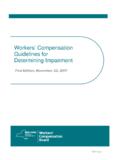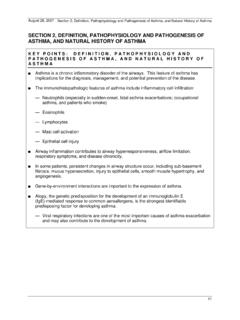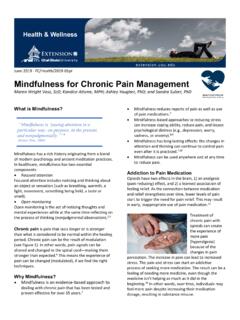Transcription of THE ROLE OF OCCUPATIONAL THERAPY IN PULMONARY …
1 OCCUPATIONAL THERAPISTS The Role of OCCUPATIONAL THERAPY in PULMONARY Rehabilitation| 1 THE ROLE OF OCCUPATIONAL THERAPY IN PULMONARY REHABILITATION PDH Academy Course #OT-1704 | 3 CE HOURSCONTINUING EDUCATIONfor OCCUPATIONAL TherapistsThis course is offered for CEUs (Intermediate level; Category 2 OCCUPATIONAL THERAPY Process: Evaluation; Category 2 OCCUPATIONAL THERAPY Process: Intervention; Category 2 OCCUPATIONAL THERAPY Process: Outcomes).The assignment of AOTA CEUs does not imply endorsement of specific course content, products, or clinical procedures by AbstractThis course provides an overview of OCCUPATIONAL THERAPY s role in PULMONARY rehabilitation, with attention to diagnoses, terminology and procedures, and process. It concludes with case audience: OCCUPATIONAL Therapists, OCCUPATIONAL THERAPY Assistants (no prerequisites).
2 NOTE: Links provided within the course material are for informational purposes only. No endorsement of processes or products is intended or ObjectivesBy the end of this course, learners will be able to: Differentiate between primary PULMONARY diagnoses Identify terminology and procedures pertaining to PULMONARY rehabilitation Recognize roles of OCCUPATIONAL THERAPY in PULMONARY rehabilitation Recall elements of three PULMONARY rehabilitation-focused case studies|The Role of OCCUPATIONAL THERAPY in PULMONARY Rehabilitation OCCUPATIONAL THERAPISTS2 INTRODUCTIONA ccording to the Center for Disease Control (CDC), 15% of adults in the United States live with a diagnosis of chronic lung disease such as asthma or chronic obstructive PULMONARY disease (COPD).1 While approximately 10% of those adults report mild symptoms, more than a third report persistent moderate to severe symptoms that greatly impact quality of Each year more than 614,000 inpatient admissions are attributed to chronic and unspecified Additionally, chronic lung disease greatly increases the risk of developing pneumonia with critical episodes accounting for approximately million inpatient admissions per Critical illness or acute lung injury, such as acute respiratory distress disease (ARDS)
3 Commonly associated with sepsis, trauma, and severe PULMONARY infections, account for approximately 15-18% of all ventilated patients in inpatient Lung disease has now become the third highest cause of mortality in the symptoms associated with chronic lung disease such as COPD include increased shortness of breath, deconditioning with general loss of muscle mass and strength impacting activity tolerance, as well as anxiety and depression. Persistent symptoms can greatly reduce function leading to a gradual loss of independence and a downward spiral in confidence based on the understanding that quality of life has been permanently ,6 Interdisciplinary rehabilitation is generally designed to alleviate and/or manage symptoms, increase strength and endurance in order to optimize function, and maximize quality of OCCUPATIONAL THERAPY (OT) can be a key member of the interdisciplinary team with its focus on providing client-centered care to maximize individual functional capacity through education, the improvement of activity Timed Topic Outline I.
4 Primary PULMONARY Diagnoses (30 minutes) chronic Obstructive PULMONARY Disease (COPD), Pneumonia (PNA), Interstitial Lung Disease (ILD), Acute Respiratory Distress Syndrome (ARDS) II. Common Respiratory Terminology and Procedures (15 minutes) III. Role of OCCUPATIONAL THERAPY in PULMONARY Rehabilitation (45 minutes) Overview, Settings, Process, Common Questions IV. Case Studies (75 minutes) V. Conclusion, Additional Resources, References, and Exam (15 minutes)Delivery & Instructional MethodDistance Learning Independent. Correspondence/internet text-based self-study, including a provider-graded multiple choice final exam. To earn continuing education credit for this course, you must achieve a passing score of 80% on the final & CancellationVisit to register for online courses and/or request correspondence PDH Academy offers self-study courses only, provider cancellations due to inclement weather, instructor no-shows, and/or insufficient enrollment are not concerns.
5 In the unlikely event that a self-study course is temporarily unavailable, already-enrolled participants will be notified by email. A notification will also be posted on the relevant pages of our who cancel orders within five business days of the order date receive a full refund. Cancellations can be made by phone at (888)564-9098 or email at and/or Special Needs Concerns?Contact Customer Service by phone at (888)564-9098 or email at Author Bio & DisclosureMidge (Annamaria) Hobbs, OTR/L, originally from the UK, graduated with an MA in OCCUPATIONAL THERAPY from Tufts University, Boston MA in 2005. She spent the following ten years working in long-term acute care gaining experience as a clinician, educator, and manager. In 2010, Midge was selected for the inaugural cohort of AOTA s Emerging Leaders Development Program (ELDP).
6 Since then she has continued to amplify AOTA s leadership initiatives by serving the Emerging Leaders Development Committee (ELDC) as Chairperson and as a member of AOTA s Volunteer Leadership Development Committee (VLDC). She is currently the Editor of AOTA s A Mindful Path to Leadership, a new online self-paced leadership development course, and she co-authored Module 3: Mentoring and Leadership with current AOTA president, Amy Lamb. Midge is currently employed as a consultant for internship development in the adolescent residential psychiatric programs at Sheppard Pratt Hospital in Baltimore MD, an adjunct professor at the MGH Institute of Health Professions in Boston, and a clinician at local rehab and assisted living facilities. Midge is also enrolled at Thomas Jefferson University for her post-professional OTD with a specialty in teaching in the digital age.
7 In her limited spare time she watches English soccer and eats a lot of : Financial Midge (Annamaria) Hobbs received a stipend as the author of this course. Nonfinancial No relevant nonfinancial relationship THERAPISTS The Role of OCCUPATIONAL THERAPY in PULMONARY Rehabilitation| 3tolerance, and psychosocial support. While many OCCUPATIONAL therapists may not choose to specialize in PULMONARY rehabilitation, many therapists working in physical medicine settings will encounter adults with limitations associated with lung disease, and it is important to understand OT s role and be prepared to provide appropriate PRIMARY PULMONARY DIAGNOSESC hronic Obstructive PULMONARY Disease (COPD)Description:COPD is not a single disease but rather an umbrella term used to describe progressive lung diseases that include emphysema and chronic bronchitis.
8 While COPD is considered preventable, it is also a progressive, life-threatening disorder in which the lungs are irreparably damaged making it difficult to breathe. Multiple factors may contribute to its onset and progression, including smoking, exposure to environmental pollutants, and a history of asthma. Prolonged exposure to toxic agents over time may result in increased mucous production ( chronic bronchitis) and tissue breakdown (emphysema).9 COPD is characterized by irreversible airflow obstruction causing dyspnea (shortness of breath) and limited reserve lung capacity with an increased risk of developing hypoxemia. 10 Worldwide, 64 million people live with COPD with an estimated 3 million deaths attributed to the disease each year. According to the World Health Organization (WHO), 80% of deaths are a result of long-term smoking, which explains why COPD typically affects older adults who may have had a longstanding history of tobacco Additionally, more women than men are now being diagnosed with the disease as a result of increased tobacco use over the past 30 ,11 In 2010, the cost of hospital admissions attributed to COPD exacerbations was estimated at $ billion dollars annually and is projected to reach $49 billion by :Upon inhalation, air is moved down through the trachea which then branches into two bronchi leading into the lungs.
9 The bronchi then branch into smaller bronchioles, which end in clusters of air sacs known as alveoli that are comprised of tiny blood vessels or capillaries. Gas exchange occurs when inspired air moves from the lungs to the bloodstream via the walls of the alveoli and carbon dioxide simultaneously moves from the blood into the capillaries of the lungs to be exhaled. A diagnosis of emphysema is indicated when the walls of the alveoli become damaged due to long-term exposure to toxic agents and the capillaries decrease their elasticity impacting gas exchange. Bronchitis is inflammation of the bronchioles indicated by an increase in mucus production and a thickening and narrowing of the airway walls. chronic bronchitis is diagnosed when increased inflammation persists over time and it is characterized by a chronic productive Picture:An increase in mucus production and narrowing of the airways significantly impacts gas exchange and may exhaust respiratory muscles and lead to an accumulation of carbon dioxide as well as an increased risk of hypoventilation.
10 Dyspnea with minor exertion is the most common symptom associated with COPD, along with a persistent cough, expiratory wheezing, and However, symptoms of COPD typically do not manifest until significant lung damage has already occurred. A diagnosis may be confirmed through a PULMONARY function test (PFT), a chest X-ray, CT scan, or an arterial blood gas analysis (ABG). Management of the disease focuses on lifestyle changes, including smoking cessation, and prescribed medication such as bronchodilators that relax the muscles around the airways and relieve coughing and For more severe symptoms, inhaled corticosteroids may be prescribed to reduce airway inflammation and minimize the risk of worsening symptoms known as an exacerbation. However, even with appropriate lifestyle changes and symptom management, individuals with COPD may experience exacerbations commonly triggered by increased exposure to irritants or a respiratory infection.








